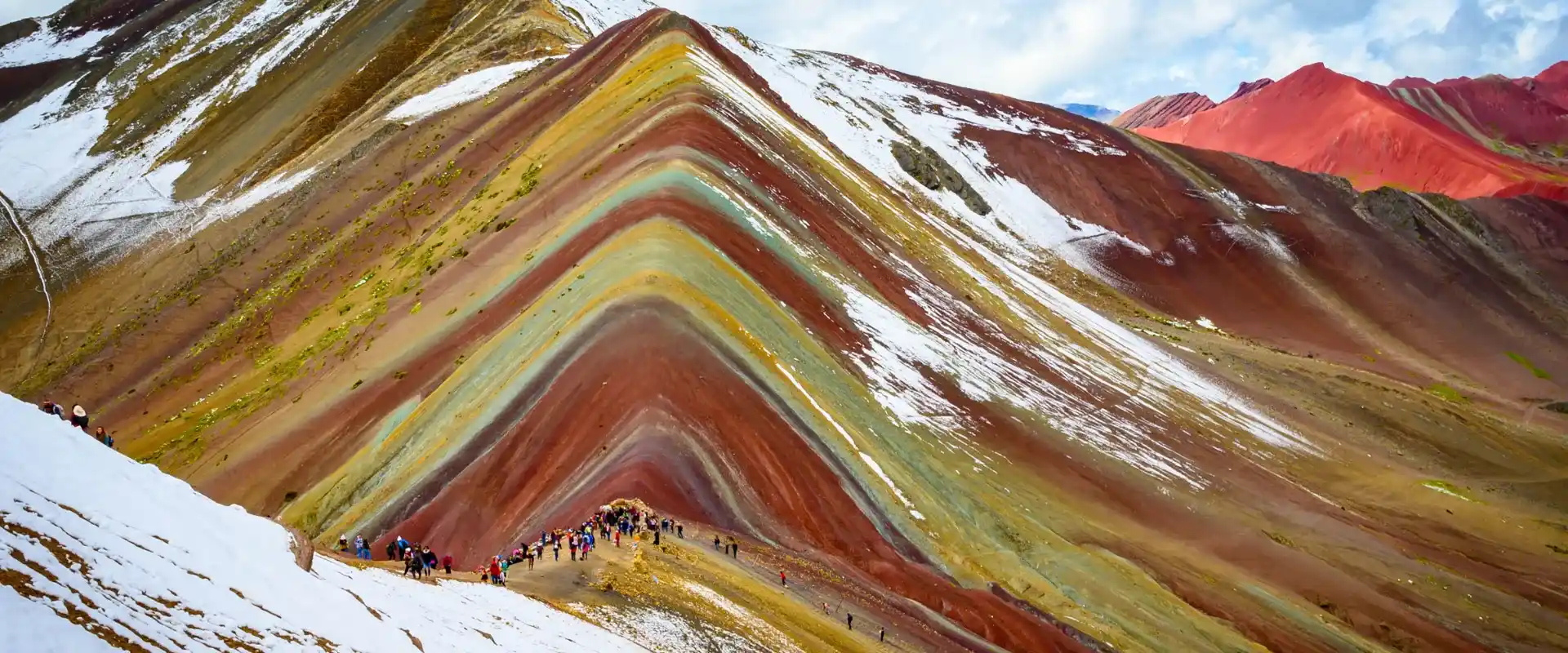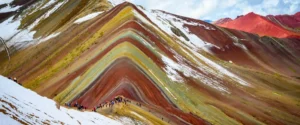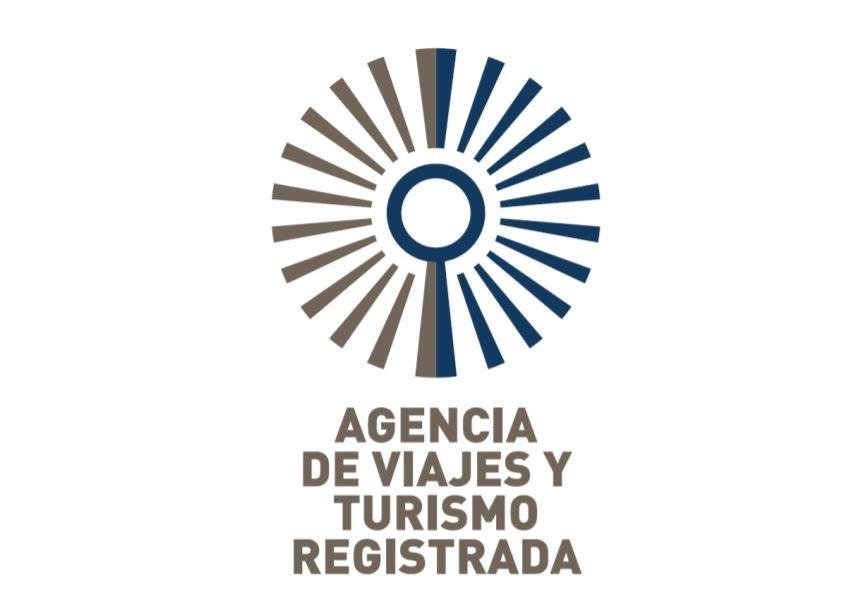Introduction to Rainbow Mountain
Rainbow Mountain, or Vinicunca, is a breathtaking geological wonder located in the Andes of Peru. Situated approximately 100 kilometers southeast of Cusco, this remarkable site has garnered immense popularity among travelers and adventurers thanks to its vibrant, technicolor slopes. The striking hues of red, yellow, green, and blue are attributed to the unique mineralogy of the region, resulting in stunning visual displays that seem almost surreal.
The formation of Rainbow Mountain is a testament to geological processes that have occurred over millions of years, including tectonic activity and erosion, which have exposed the varied strata of minerals. This intricate display serves not only as a natural masterpiece but also as a reflection of the rich geological history of the region. Enhancing its allure is the traditional significance of the site to local indigenous communities, who regard it as a sacred landscape. The mountain is embedded in Andean culture, where it holds great spiritual importance and is often associated with various local legends.
A noteworthy factor contributing to the rising popularity of Rainbow Mountain is its accessibility. Improved infrastructure has made it feasible for visitors from around the globe to experience the striking views firsthand. Travelers are drawn to the area not only for the panoramic vistas but also for the experience of trekking through the picturesque valleys of the Andes, encountering local wildlife, and immersing themselves in the vibrant culture. However, it is essential for visitors to consider the best time to visit Rainbow Mountain and be mindful of its high altitude, as these factors can significantly influence their experience. In doing so, travelers can fully appreciate the beauty and significance of this unique destination in Peru.
Best Time to Visit Rainbow Mountain
When planning a visit to Rainbow Mountain, Peru, understanding the seasonal variations is crucial for an optimal experience. The best time to visit this stunning natural wonder is during the dry season, which typically spans from May to September. During these months, visitors can expect clearer skies and drier trails, ultimately enhancing visibility of the mountain’s vibrant colors. The wet season, on the other hand, lasts from November to March, bringing increased rainfall that can obscure the view and make trekking conditions challenging.
Specifically, the months of June, July, and August are often regarded as prime time for exploration due to the peak of the dry season. During these months, the chances of encountering sunny weather are significantly higher, allowing hikers to fully appreciate the unique hues of the mountain, which are best seen when the sun casts a warm light on the landscape. Additionally, trekking during this period generally provides more comfortable temperatures, enabling visitors to enjoy the stunning panoramas without the discomfort of harsh weather.
<pin a="" addition="" align="" also="" and="" beauty="" can="" celebrated="" complements="" considering="" cultural="" deeper="" engaging="" enhances="" events="" example,="" experience="" experience.
In conclusion, to maximize the opportunity to witness the breathtaking landscapes of Rainbow Mountain, it is advisable to plan your visit between May and September, ideally during the dry months of June, July, and August. The beautiful clarity of the skies during these times, along with the vibrant local culture, promises an unforgettable adventure at this remarkable destination.
Understanding Altitude: Health Tips for Travelers
Rainbow Mountain, Peru, located in the Andes, stands at an impressive altitude of approximately 5,200 meters (17,060 feet) above sea level. This significant height poses challenges for many travelers, as the body may struggle to adapt to such low levels of oxygen. Understanding the potential effects of altitude is crucial for anyone planning to hike this remarkable destination.
Prior to the hike, it is essential to allow adequate time for acclimatization. Visitors are advised to spend at least a couple of days in Cusco or other high-altitude areas before attempting the trek to Rainbow Mountain. This practice helps the body to adjust gradually, reducing the risk of altitude sickness. Additionally, staying well-hydrated is vital. Drinking plenty of water helps ensure that the body remains hydrated and aids in adjusting to the altitude. It is recommended to consume at least 3 to 4 liters of water daily during the acclimatization period.
Physical preparation is also a key factor in a successful hiking experience. Engaging in aerobic activities such as walking, hiking, or cycling in your home country can build stamina and endurance, making the trek less daunting. It is advisable to avoid alcohol and smoking during this time, as these substances can hinder oxygen absorption and heighten the symptoms of altitude sickness.
Travelers should remain vigilant for symptoms of altitude sickness, which can include headaches, nausea, dizziness, and shortness of breath. If symptoms persist or worsen, it is crucial to descend to a lower altitude and seek medical attention if necessary. Adhering to these health tips will not only enhance the experience but will also ensure a safer trip to admire the stunning views of Rainbow Mountain, Peru.
Concluding Thoughts and Travel Tips
As your journey to the breathtaking Rainbow Mountain in Peru approaches, it’s crucial to keep several travel tips in mind to ensure a smooth and enjoyable experience. First and foremost, planning ahead is vital. Given the increasing popularity of this remarkable landscape, the best time to visit is typically during the dry season, which spans from May to September. During these months, the weather is more stable, allowing for clearer views of the vibrant, colorful mineral layers that characterize the mountain.
When contemplating transportation options to Rainbow Mountain, travelers have a few choices. Many visitors opt for guided tours available from Cusco, which provide transportation, expert guidance, and often include meals. Alternatively, independent travelers can take a bus or taxi to the nearest village, which offers a starting point for the hike. Regardless of the mode of transportation selected, it is advisable to leave early in the morning to avoid crowds and fully appreciate the serenity of the area.
Altitude sickness is an important consideration when planning your visit to Rainbow Mountain, as the peak sits at an impressive altitude of over 5,000 meters (approximately 16,400 feet). To acclimatize, spend a few days in Cusco before your trek, drink plenty of water, and consider bringing altitude sickness medication as a precaution. Proper gear is essential for the hike. Ensure you have sturdy hiking boots, warm layers, sunscreen, and adequate water as temperatures can vary significantly throughout the day.
Lastly, hiring a local guide not only enhances the experience by providing insights into the geography and culture but also supports the local economy. In conclusion, with careful planning and consideration of travel tips, visitors can fully embrace the extraordinary natural wonders that Rainbow Mountain has to offer in Peru.









